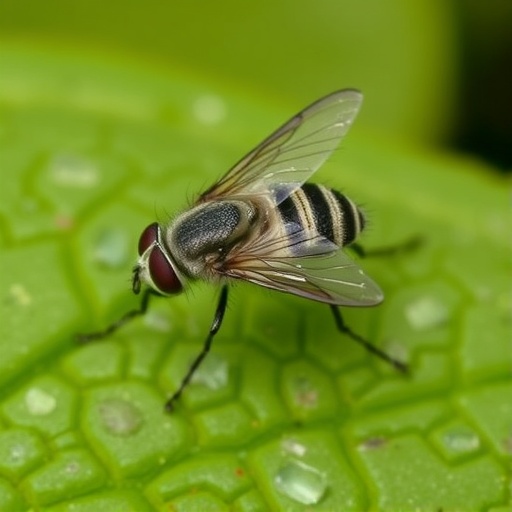In the ever-evolving field of entomology, researchers constantly seek innovative solutions to combat pest species that threaten biodiversity and ecosystem balance. One of the significant pests under scrutiny is the Hemlock woolly adelgid, scientifically known as Adelges tsugae. This tiny insect, indigenous to Asia, has established a notorious reputation as an invasive species in North America, causing substantial damage to Eastern Hemlock trees. Recently, a remarkable research endeavor led by Andrews, Jones, and Whitmore has uncovered intriguing feeding deterrents found in biological control flies, offering a potential beacon of hope for mitigating the devastation caused by A. tsugae.
Biological control, an ecological approach to pest management, leverages the natural predation behaviors of certain species to control pest populations. The concept hinges on the understanding that ecosystems possess intricate balances where predators can effectively mitigate the presence of invasive species. In this recent study, researchers delve deep into the mechanism behind specific deterrents that these beneficial flies exhibit, proposing they may help regulate A. tsugae populations through their feeding behavior.
Understanding the feeding habits of A. tsugae is crucial for researchers. The adelgid feeds on the sap of Hemlock trees, leading to tree decline and eventual death if left unchecked. The researchers speculated that certain biological control flies developed adaptations that either dissuade A. tsugae from feeding or directly interfere with their capacity to extract sap from the trees. The interaction between these flies and A. tsugae can reveal powerful strategies for maintaining the health of Hemlocks, arguably one of the most critical trees in eastern forests.
The study employed a combination of field trials and laboratory experiments to understand the dynamics between biological control flies and A. tsugae. In seamless collaboration, the team observed and documented various scenarios where fly behavior seemed to deter adelgid feeding activities. These findings highlight how myriad factors, including scent and chemical cues, play vital roles in these interspecies interactions. By analyzing specific responses, the researchers could pinpoint which deterrents were predominantly effective, thus providing a foundation for future control methods.
Furthermore, the researchers investigated the potential chemical compounds secreted by the flies that may impact A. tsugae behavior. These compounds showed promise as natural deterrents, functioning to repel or disrupt the feeding activities of the adelgid. Their discovery exemplifies nature’s ingenuity, where various species evolve mechanisms not just for survival but as a means to maintain ecological integrity within their shared habitat.
Ultimately, the implications of these findings extend beyond mere pest control. As climate change continues to alter ecosystems, understanding how biological control agents can adapt to and manage invasive species becomes progressively more critical. The interaction between these biological control flies and A. tsugae not only bolsters our understanding of ecological dynamics but also provides potential pathways toward sustainable forest management strategies in the face of rapid environmental changes.
Through the lens of biological insights, researchers emphasize the significance of ecological integrity in fostering resilience among forest ecosystems. The Hemlock trees serve as critical habitats for many species of fauna and flora, with their decline potentially triggering cascading effects across diverse ecosystems. Thus, employing biological control flies as mediators against A. tsugae may well reflect a larger ecological strategy: harmonizing human intervention with the inherent balances of nature to preserve biodiversity.
As awareness about the importance of sustainability intensifies, the study led by Andrews, Jones, and Whitmore stands as a testament to the potential of leveraging beetles, wasps, and other insects in the battle against invasive species like A. tsugae. These findings could lay the groundwork for innovative pest management models that prioritize the use of naturally occurring species to restore ecological balance, supporting resilience in forested areas decimated by invasive pests.
The researchers stress the importance of continued studies that extrapolate and apply the principles learned from this investigation. As they continue their work, they aim to refine methodologies that extend the practical applications of these biological deterrents, paving the way for more efficient strategies for natural pest control that can be employed in varying contexts across broader geographical locations.
Moreover, the implications of such research resonate with conservationists, policymakers, and land managers. Integrative approaches, incorporating biological control strategies, can enhance the well-being of both managed and natural ecosystems. Establishing collaboration among scientific communities and stakeholders further facilitates agile responses to the challenges posed by invasive species, particularly in light of climatic fluxes threatening forest health.
In summary, the potential revelations drawn from this research into the feeding deterrents of Adelges tsugae present a multifaceted opportunity to explore evolutionary ecology’s role in pest management. At a time when the urgency of tackling invasive species has never been higher, the collective expertise exhibited in this study cultivates optimism within the scientific community regarding the restoration and protection of delicate ecosystems. Innovative strategies derived from nature can indeed inspire actionable solutions against formidable ecological threats posed by invasive species.
As the research continues to unfold, we are reminded that at the intersection of biodiversity, ecological health, and technological advances lies the key to future sustainability efforts. The findings from Andrews, Jones, and Whitmore thus signal a substantial leap forward in our understanding of nature’s dynamics, enabling a more nuanced approach toward achieving long-lasting ecological balance essential for the survival of the species and ecosystems we so fervently strive to protect.
Subject of Research: Hemlock woolly adelgid (Adelges tsugae) and biological control flies
Article Title: Potential feeding deterrents of Adelges tsugae found in biological control flies.
Article References:
Andrews, O., Jones, A.C., Whitmore, M. et al. Potential feeding deterrents of Adelges tsugae found in biological control flies.
Sci Nat 112, 45 (2025). https://doi.org/10.1007/s00114-025-01996-y
Image Credits: AI Generated
DOI: https://doi.org/10.1007/s00114-025-01996-y
Keywords: Biological control, Adelges tsugae, Hemlock trees, ecological balance, invasive species, pest management.




